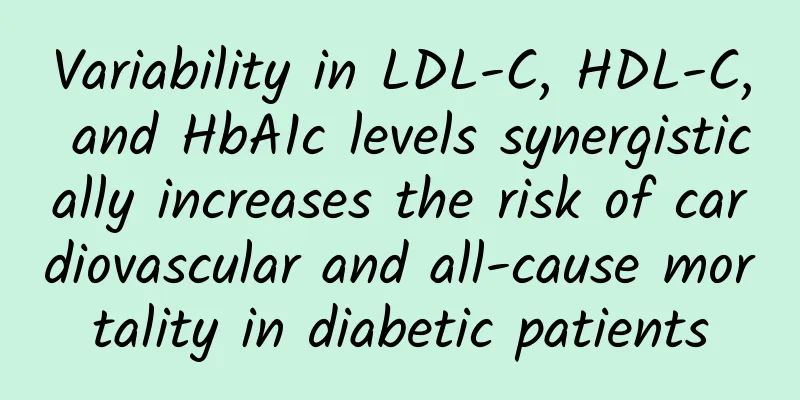Variability in LDL-C, HDL-C, and HbA1c levels synergistically increases the risk of cardiovascular and all-cause mortality in diabetic patients

|
Diabetes is a major public health problem worldwide. Identifying more interventionable risk factors and further reducing the residual risk of cardiovascular and cerebrovascular events and death in the diabetic population has always been a hot topic and focus of medical research. The long-term variability of multiple risk factors such as blood pressure, blood lipids, and glycosylated hemoglobin is closely related to the risk of cardiovascular and cerebrovascular events and death. In addition, the superposition of metabolic risk factors such as dyslipidemia and impaired glucose tolerance may have a multiplier effect on cardiovascular risk and death. Therefore, we hypothesized that the superposition of variability in low-density lipoprotein cholesterol (LDL-C), high-density lipoprotein cholesterol (HDL-C), and glycosylated hemoglobin (HbA1c) levels may synergistically increase the risk of death in the diabetic population. Based on the above background, Dr. He Panpan and his team from the National Clinical Research Center for Kidney Diseases of Nanfang Hospital published a research paper in the journal Diabetology & Metabolic Syndrome , which found that the inter-visit variation of LDL-C, HDL-C and HbA1c jointly affects the risk of cardiovascular death and all-cause death in diabetic patients. Diabetic patients with high coefficients of variation of LDL-C, HDL-C and HbA1c have the highest risk of cardiovascular death and all-cause death. Methods: A total of 5194 patients with type 2 diabetes were enrolled in the Action to Control Cardiovascular Risk in Diabetes (ACCORD) lipid trial and the inter-visit variation in LDL-C, TG, HDL-C, and HbA1c from baseline to 2 years of follow-up was evaluated, expressed as the coefficient of variation (CV). During a median follow-up of 3.0 years after the end of the first 2 years of variability measurement, there were 305 all-cause deaths, including 144 cardiovascular deaths. The positive association between LDL-C CV and cardiovascular mortality was significantly enhanced in participants with high HDL-C CV and high HbA1c CV (interaction P values less than 0.05 for both). However, there was no significant interaction between LDL-C CV and triglyceride CV (interaction P = 0.591). The results for all-cause mortality were similar. In conclusion, this paper first found that the variability of LDL-C, HDL-C and HbA1c can synergistically increase the risk of cardiovascular death and all-cause death in patients with diabetes. This finding emphasizes the importance of simultaneously controlling the volatility of LDL-C, HDL-C and HbA1c in patients with type 2 diabetes to reduce their subsequent mortality risk . References: He P, Gan X, Wu Q, Ye Z, Yang S, Zhang Y, Li H, Zhou C, Zhang Y , Liu M, Qin Editor: He Panpan Huang Yu Reviewer: Qin Xianhui Reprint: Please contact us and indicate the source. |
<<: Ginger is a holy medicine for vomiting
>>: The Lancet sub-journal: 5 good habits that can help Chinese people live longer
Recommend
How to treat high testosterone in girls
High testosterone is a common female endocrine im...
Is watery leucorrhea normal after abortion?
I believe everyone already knows that vaginal sec...
How many days of delayed menstruation can detect pregnancy
Some women notice that they are pregnant because ...
What skin care products does a 23-year-old girl use?
The age of 23 is not too young. At this time, we ...
How long after caesarean section can I have a second child
Women who have undergone cesarean section will ne...
How much almonds should be eaten in a day? Where are almonds produced and what are their growth characteristics?
Almonds are most easily digested and absorbed by ...
Do women still have menstruation during menopause?
Menopause seems to have become synonymous with wo...
What to eat for breast enlargement?
Women all pursue a graceful figure with a protrud...
Clearly understand your "heart" electrogram sinus arrhythmia
Sinus arrhythmia is the most common result in the...
What is the cause of yellow leucorrhea?
Women must be sufficiently vigilant if they find ...
What to do with spots on face after miscarriage?
Women are most likely to develop spots on their f...
Will holding urine cause gynecological diseases?
Due to the differences in physiological structure...
Focus on 5 aspects to teach you how to easily achieve individualized nutrition management during pregnancy and childbirth
Author: Liu Yanping, deputy chief physician of Pe...
Is a light diet equal to being a vegetarian? A graphic explanation
"Don't eat too much greasy food, and eat...
What to do if you have uterine prolapse during pregnancy? Chinese and Western medicine treatment is effective
The main reason for uterine prolapse after pregna...









